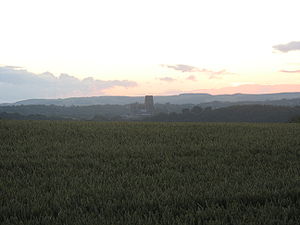Dark Age Haunting in the County Durham November 14, 2010
Author: Beach Combing | in : Medieval , trackback Beachcombing likes to think of the little village of Shincliffe sometimes as night is falling, particularly if it’s raining. True, he’s never been to this particular corner of the north of England. But he’s done the next best thing – looked at google earth and several OS maps. And he suspects that he knows it as well as any other non-visitor.
Beachcombing likes to think of the little village of Shincliffe sometimes as night is falling, particularly if it’s raining. True, he’s never been to this particular corner of the north of England. But he’s done the next best thing – looked at google earth and several OS maps. And he suspects that he knows it as well as any other non-visitor.
His fascination in this obscure Co. Durham settlement stems from its name, which has not changed substantially from when it was first recorded almost a thousand years ago.
C. 1110 it was written Schinneclif. And as this is and was an obscure village it is possible that the name was already bandied around in a similar form c. 700 and that no one troubled to write it down in those pre-literate times, despite it being so close to Durham.
Certainly, it didn’t make it into the exhaustive Domesday Book in 1086.
The second part of the name is ‘cliff’ and very likely refers to the steep bank of forested slopes that comes up from the river Wear. Beachcombing’s trusty map tells him that there is a mix there of deciduous and conifer trees. The Roman and the medieval crossing of the river was nearby.
Shin or Schinne comes instead from the Anglo-Saxon word scin meaning ‘shining one’. The word was coined in a period of English history – often and correctly called the Dark Ages – when historians know painfully little about what went on. However, there is no question that the scin – pronounced like the part of Beachcombing’s leg that Mrs B. often kicks – was some kind of luminous supernatural being. True the scin is not one of the classic beasties that the early English dreamed up: e.g. elves or shucks. But scin was associated with the words for magic and witchcraft and could even be employed for a demon. Beachcombing likes to think of it as a bogey man connected to the ruins of the Roman bridge, a kind of Geordie troll, but this is just pure self-indulgence.
Something, in any case, was believed to dwell on the slope here and sent the local children to bed with nightmares.
The Christianisation of Dark Age England was frighteningly complete and names of this sort are among the few precious clues we have of what animated the pre-Christian medieval populations. Was the scin originally a deity or was it a monster? Did the locals sacrifice to appease it? Or did they work charms against it? No one knows but it is exciting to be able to ask the questions while bemoaning the fact that all we have left of an entire religious universe is a mispronounced syllable in a modern placename.
Not much then to get excited about?
Beachcombing can only speak for himself, but he would trade an evening in the woods of Shincliffe holding a torch with dodgy batteries for yet another tiresome read of Beowulf. It would certainly be good for his adrenalin and he likes the idea of a Northumbrian Blair Witch Project.
Beachcombing is not a believer in ghosts, but he is struck by how often ghostly legends stick to one locale. And he also has a short file of Anglo-Saxon precedents for long-lasting, Beachcombing will call them, ‘hauntings’. Beachcombing has, however, been unable to find any evidence of a ghost legend in this part of the world. Any help from those who have actually been to Shincliffe? Or any other ancient haunted locatons evinced by names? drbeachcombing AT yahoo DOT com
Beachcombing apologises that he didn’t think to put this online at Halloween when Little Miss B was being woken up by trick and treaters. He would also like to note to any Shincliffers who pass by that – on the basis of google earth and large scale maps – he happens to think that they live in a beautiful part of the country.


